
PUMPA - SMART LEARNING
எங்கள் ஆசிரியர்களுடன் 1-ஆன்-1 ஆலோசனை நேரத்தைப் பெறுங்கள். டாப்பர் ஆவதற்கு நாங்கள் பயிற்சி அளிப்போம்
Book Free DemoIn Indian food, spices play a vital role. Spices are considered to be the "soul" of Indian cuisine. Spices remind us of two things:
- Tasty food
- Healthy food
Spices are added in the food:
- To balance the nutrition.
- To keep us healthy.
- There are no calories or fat content in any spices - hence it adds taste without adding any unhealthy substances.
The essential Indian spices are cumin, mustard, pepper, cloves, fennel, cinnamon and turmeric.
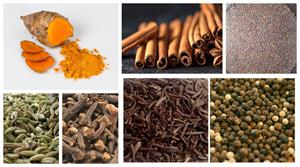
Clockwise - Turmeric, cinnamon, mustard, pepper, cumin, cloves and fennel.
When we say "Indian food" - the first thought that comes to people's mind are "spicy curries". Curry comes from the Tamil word "Kari" which means sauce. A sauce or Kari is something which is cooked with a mixture of spices, flavours and herbs. This mixture of spices keeps changing according to places and people's tastes. Some people prefer mild spices, while others prefer strong flavours. In Indian dishes, a variety of flowers, leaves, roots, stems, seeds, and bulbs are combined to produce many items with different flavours like - sweet, pungent, hot, sour, spicy, fragrant, sharp, mild etc. Spices go well with any food - rice, meat, vegetables, fish etc. It gives the dishes a unique taste that keeps people wanting more of the food.
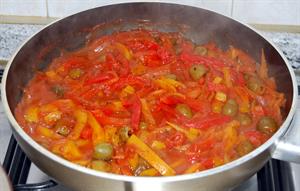
A spicy Indian curry!
Apart from making the food tasty, spices also play with our minds. Many merchants tried to master the spice trade since there was a huge competition in the spices industry. America and Asia were continents that were colonized due to the spice trade. Colonization means the process of settling among and establishing control over the native people of an area.
In 1492, a merchant sailor named Columbus wanted to find India and buy pepper; but he went West and landed in America and found the spice chilli. After six years (in 1498), another sailor Vasco da Gama travelled around Africa and finally reached Kozhikode in Kerala, to find pepper. Arabs and Romans were doing successful business in spices till then. After the above two voyages, the Arabs and Roman trade were ended, and a whole new stage was set for the spice trade.
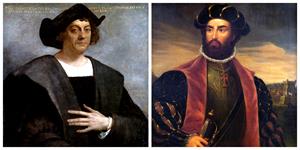
*Columbus and Vasco da Gama - changed the entire spice trade scene!
Let us explore how the spice trade changed the trade scene.
The most important part of India's trade was spices. India's trade started as early as 7000 years before the Greek and Roman civilizations. India traded spices, perfumes and textiles with:
- Mesopotamia
- China
- Sumeria
- Egypt and
- Arabia
There have been written proof in Indian epics (great legends) from 1st century CE about Indians' trade of cloves. Cloves are flavorful and aromatic spices, derived from dried flowers of the clove plants.
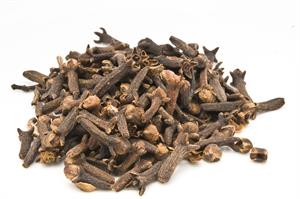
Clove - the aromatic spice!
Ayurveda is the traditional system of Hindu medicine, that is popular till date. The doctors of Ayurveda have explained the usage of spices for cooking and as medicines, about 1000 years ago. It was not easy to procure the spices in those days; some people have even risked their lives to get Indian spices. However, these spices are readily available to us today.
During the Middle Ages (that is from the 5th to 15th century), one pound of ginger (less than half a kilogram) was equal to the price of a sheep.

Both were of the same value!
A pound of mace (less than half a kilogram), was equal to the price of three sheep or half the price of a cow! It is good to note that pepper was the most precious of all spices.
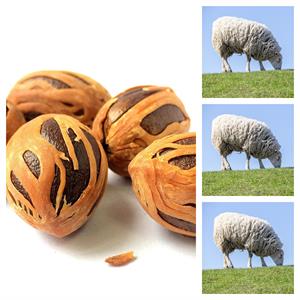
Half a kg of mace priced equal to three sheep!
The world needed some spices from India at any cost - cardamom, cloves, ginger, mace, and nutmeg were some of the few spices that went abroad to give a delicious flavour in the international kitchens. Mace and nutmeg are almost the same spice - the red flesh on the nutmeg seed is dried and used as mace, (refer picture above).
Spices have been used in cooking for about 52,000 years! No one knows how spices came to use for the first time, but it is guessed that it was by trial. Till now, spices are an important part of our food. In earlier days, spices were costly, and it was not easy to obtain them. Therefore spice trade was a profitable business, and those who traded spices became rich. Now since these spices are easily available, pepper and cinnamon have come to a stage where the rates have become normal. The grandness and glory of the spices may have reduced due to its ready availability today, but they will never lose their places in our Indian kitchens!
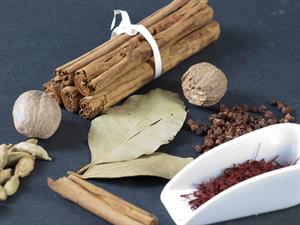
Spices, though not glorified today - still they are an important part of our kitchen!
Black pepper was also known as "black gold" because it was considered very precious. It was available in the Kerala coast, and it was traded from there. Indian farmers have been growing pepper for about 5000 years. They sold it to other countries in North and West Asia. Slowly the export sale extended to Greece, Rome, Europe, China, and the Islamic Empire (Arabia, Persia, Armenia, Egypt). Ancient Rome also loved the black pepper because there have been recipes from rich families of the Roman dynasty, where pepper was used. The Romans sent 120 ships from Egypt, per year, to India for selling their goods and taking back huge quantities of pepper.
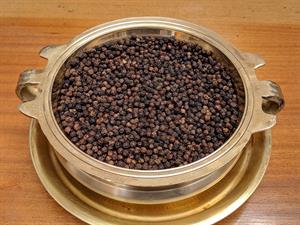
Black gold, in a golden bowl!
Cinnamon is another spice that has been used widely by Indians for a long time. In 2700 BC, the Chinese had written about the same. Adding cinnamon to food has two uses:
- It adds a wonderful flavour to the food.
- It acts as a preservative - it does not let food decay.
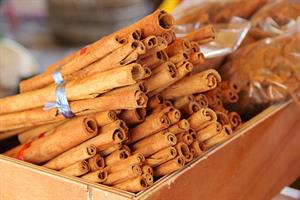
The fragrant, spicy cinnamon!
People from all over the world loved the smell and taste of cinnamon and appreciated it. They spent huge amounts on buying cinnamon. The Greeks, Romans, and Egyptians also bought cinnamon from India. During the Middle Ages (5th to 15th century), the people of Venice, a city in Italy (in Europe) - known as Venetians became rich just by charging a tax on the cinnamon that was imported from India to Europe and the Mediterranean countries (around the Mediterranean sea).
Reference:
*Image courtesy - https://en.wikipedia.org/wiki/Vasco_da_Gama#/media/File:Vasco_da_Gama_-_1838.png;
https://commons.wikimedia.org/wiki/File:Christopher_Columbus.PNG